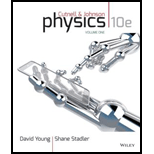
The rank of setups in descending order according to the work done by hand.
Answer to Problem 2FC
The correct option is (e) C, B, A.
Explanation of Solution
Given data:
The resistance of bulb A is
The resistance of bulb B is
The resistance of bulb C is
Formula used:
Write the expression for power
Here,
V is voltage, and
R is resistance.
Explanation:
The work done by hand in
Modify the equation (1).
Here,
V is constant.
Thus, the power used by bulb has an inverse proportional change with the change in resistance. The small resistance causes the greater power usage, whereas the high resistance results in a low power usage.
The bulb C has the lowest resistance and possesses greatest power usage.
The bulb B has second lowest resistance and possesses the second greatest power usage.
The bulb A has highest resistance and possesses lowest power usage.
Hence, the rank of powers from highest to smallest is,
Here,
Similarly the rank of work done by hand from largest to smallest is,
Here,
Conclusion:
Thus, the correct option is (e) C, B, A.
Want to see more full solutions like this?
Chapter 22 Solutions
Physics, Volume One: Chapters 1-17
 College PhysicsPhysicsISBN:9781305952300Author:Raymond A. Serway, Chris VuillePublisher:Cengage Learning
College PhysicsPhysicsISBN:9781305952300Author:Raymond A. Serway, Chris VuillePublisher:Cengage Learning University Physics (14th Edition)PhysicsISBN:9780133969290Author:Hugh D. Young, Roger A. FreedmanPublisher:PEARSON
University Physics (14th Edition)PhysicsISBN:9780133969290Author:Hugh D. Young, Roger A. FreedmanPublisher:PEARSON Introduction To Quantum MechanicsPhysicsISBN:9781107189638Author:Griffiths, David J., Schroeter, Darrell F.Publisher:Cambridge University Press
Introduction To Quantum MechanicsPhysicsISBN:9781107189638Author:Griffiths, David J., Schroeter, Darrell F.Publisher:Cambridge University Press Physics for Scientists and EngineersPhysicsISBN:9781337553278Author:Raymond A. Serway, John W. JewettPublisher:Cengage Learning
Physics for Scientists and EngineersPhysicsISBN:9781337553278Author:Raymond A. Serway, John W. JewettPublisher:Cengage Learning Lecture- Tutorials for Introductory AstronomyPhysicsISBN:9780321820464Author:Edward E. Prather, Tim P. Slater, Jeff P. Adams, Gina BrissendenPublisher:Addison-Wesley
Lecture- Tutorials for Introductory AstronomyPhysicsISBN:9780321820464Author:Edward E. Prather, Tim P. Slater, Jeff P. Adams, Gina BrissendenPublisher:Addison-Wesley College Physics: A Strategic Approach (4th Editio...PhysicsISBN:9780134609034Author:Randall D. Knight (Professor Emeritus), Brian Jones, Stuart FieldPublisher:PEARSON
College Physics: A Strategic Approach (4th Editio...PhysicsISBN:9780134609034Author:Randall D. Knight (Professor Emeritus), Brian Jones, Stuart FieldPublisher:PEARSON





